|
|
|
Sort Order |
|
|
|
Items / Page
|
|
|
|
|
|
|
| Srl | Item |
| 1 |
ID:
144350
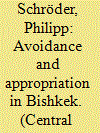

|
|
|
|
|
| Summary/Abstract |
Much has changed since Frunze was renamed Bishkek in 1991 and became the capital of independent Kyrgyzstan. Though it was once considered to be among the ‘greenest’ and most ‘orderly’ cities of the Soviet Union, today many of its long-term residents complain about the new settlements (novostroiki) that have emerged during the last two decades. To Bishkek's urbanites, the recent arrival of migrants is not associated with an escape from rural poverty and a rightful struggle for civic rights, but indicates a massive cultural and aesthetic degradation of familiar urban life. In this article, beyond contesting narratives of cosmopolitan nostalgia vs. legitimate belonging, I investigate how urban practitioners in fact produce and deal with different spaces in the city. My ethnographic accounts not only identify social avoidance as an essential pulse of Bishkek's current rhythm, but also illustrate that after a period of post-rural socialization previously stigmatized migrants may manage to smoothly blend into urban spatial flows and lifestyles.
|
|
|
|
|
|
|
|
|
|
|
|
|
|
|
|
| 2 |
ID:
127513
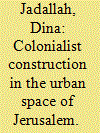

|
|
|
|
|
| Publication |
2014.
|
| Summary/Abstract |
This article examines the matrix of Israel's urban interventions using territorial and demographic engineering to transform Jerusalem into a closer approximation of Zionist ideological conceptualization. It argues that the state deploys archaeological, cultural, sociopolitical, territorial, and urban design instruments to deconstruct or re-narrate the other histories and characteristics of the city in order to preempt alternative sovereignties. The asymmetrical power of the Israeli state is constantly challenged in urban spaces and quotidian practices by Palestinians who hold competing discourses. Palestinians contest Israel's conceptualization through discourses that do not ascribe to the state project, emphasizing that identity is not exclusive to one ethnicity or religion, while working to sustain and strengthen an alternative sovereignty.
|
|
|
|
|
|
|
|
|
|
|
|
|
|
|
|
| 3 |
ID:
149426
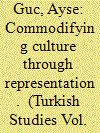

|
|
|
|
|
| Summary/Abstract |
This paper attempts to analyze two intertwined discourses on Mardin’s urban space that commodify its culture by representing it as an ideal place of living together. First is the official discourse which constructs an image for Mardin as a city of tolerance and belief, and second is the demotic discourse of the Mardinites which appropriates and contests this image. By describing these discourses, the paper intends to indicate the hiatus between the reality of Mardin’s locality and its representation. The paper argues that the discourses commodify Mardin’s cultural traits and strengthen local power relations by reproducing its urban space.
|
|
|
|
|
|
|
|
|
|
|
|
|
|
|
|
| 4 |
ID:
177973
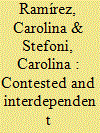

|
|
|
|
|
| Summary/Abstract |
This article examines experiences of making, inhabiting and appropriating space, in relation to the transformations of the political economy in an increasingly multicultural urban setting. Through processes of social production and construction of space, it explores the material, societal and symbolic processes at play. The entry points are memories, images, uses and material connection to Patronato neighbourhood (Santiago, Chile) by people of Korean and Palestinian ancestry. It analyses how claims of space authenticity, processes of ethnicisation and material appropriation of space – commonly understood as given by ‘cultural differences’ – respond to historical, economic and political shifts happening at a global and local level. Moreover, challenging the prism of socioeconomic conflict and separation, it shows emerging dynamics of social interdependence and adjustment, taking place alongside the reorganisation of ethnic boundaries. Such reorganisation allows settled migrants to develop a sense of belonging and control over space in a rapidly changing neoliberal city.
|
|
|
|
|
|
|
|
|
|
|
|
|
|
|
|
| 5 |
ID:
168819
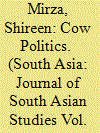

|
|
|
|
|
| Summary/Abstract |
This article explores the spatial politics of situating slaughterhouses at the margins of Mumbai city enacted by the sanitary civic state and the caste labour of the butcher community. While the sanitary state mobilises colonial discourses of sanitation that deem animal slaughter unhygienic and so needing to be located at the shifting periphery of the city, an ethnography of the Muslim sub-castes of mutton and beef butchers suggests that animal slaughter is a form of caste labour that involves cultivating hereditary skills of working with flesh, bone and blood, which the Mumbai butchers refer to as ‘karigari’ (artisanship). Their caste labour is resisting the reconfiguration of the meat trade, which they view as fragmenting the community’s control over their labour. By bringing theories of urban space, state and caste among urban Muslims into the conversation, the article describes the ways in which scientific and communal ideas of sanitation are consolidated along a continuum. It also describes the ways in which caste and religion condense along an axis to form analogous structures that are deployed by the beef and mutton butchers to resist these spatial shifts.
|
|
|
|
|
|
|
|
|
|
|
|
|
|
|
|
| 6 |
ID:
123185
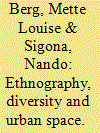

|
|
|
|
|
| Publication |
2013.
|
| Summary/Abstract |
This article is an introduction to a special issue on ethnography, diversity and urban space. It places the 'diversity turn' within studies of migration and multiculture historically and discusses the implications of concepts such as 'diversity' and more recently 'super-diversity' for scholarship, policy and identity politics. It argues that diversity is a helpful concept for studies of migration and multiculture because it avoids the essentialism and bias towards ethnic affiliation often characterising studies within the multiculturalism framework, while being more grounded locally than studies within the transnationalism framework. It examines the methodological implications of increasing diversity and complexity on ethnographic studies and the definition of the 'field'. It makes the point that increasing urban diversity poses a challenge to ethnographic ideals of 'immersion' and wholeness. Finally, it introduces the individual articles in the special issue.
|
|
|
|
|
|
|
|
|
|
|
|
|
|
|
|
| 7 |
ID:
164715
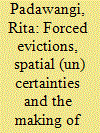

|
|
|
|
|
| Summary/Abstract |
This article considers the relationship between forced evictions and the ‘exemplary centre’ through an examination of three urban waterfront sites in Indonesia in comparative perspective. How is the notion of the ‘exemplary centre’ related to forced evictions and the aspirations of marginalised populations in contemporary cities of Indonesia? What are the chances of asserting alternative ideologies when a capital‐centric and modernist vision of the city as ‘exemplary centre’ dominates official planning paradigms? Competing visions of the ‘exemplary centre’ arise from distinct centres of power, from the state level to the grassroots community level; however, the dominant state vision of urban space is often internalised by those most at risk of displacement by modernist projects. Strategies to thwart forced evictions in riverbank settlements in Jakarta, Solo, and Surabaya offer alternative imaginings of the ‘exemplary centre’ – imaginings that enable the urban poor to visualise their hopes and to overcome the spatial uncertainties that characterise their everyday lives. While these efforts indicate resistance to marginalisation, they also provide a distinct kind of ‘exemplary’ vision based on residents’ own understanding of ideal city living. Concurrently, some alignment to existing ‘exemplary centre’ narratives is traceable in the effort to assert these alternatives.
|
|
|
|
|
|
|
|
|
|
|
|
|
|
|
|
| 8 |
ID:
131544


|
|
|
|
|
| Publication |
2014.
|
| Summary/Abstract |
Aspects of space and place shape daily life, social structures, politics, and intimate relations among people. In the late 1980s and 1990s, anthropologists, geographers, and sociologists-influenced by the writings of Michel Foucault and Henri Lefebvre on the meaning of social space-started to highlight the spatial in their analysis of social phenomena. These scholars focused on the production of urban space and asserted that space is dynamic and often shaped by the needs of its users as well as by those who design it. With the exception of Setha Low's work on Latin America, these writings were mostly centered on the United States.
|
|
|
|
|
|
|
|
|
|
|
|
|
|
|
|
| 9 |
ID:
134167
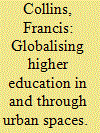

|
|
|
|
|
| Publication |
2014.
|
| Summary/Abstract |
This paper explores the connections between universities and cities in a moment of heightened emphasis on international student mobilities and globalising processes in Asian higher education. In particular, I seek to draw attention to the contingent assembly of the urban and its role in globalising higher education by highlighting the ways in which urban spaces draw together different sorts of trans-local connections and flows. To explore this approach, I discuss the globalisation of higher education in South Korea, and the significance of Seoul in these processes through a focus on two leading universities - Korea University and Seoul National University. To highlight the importance of trans-local connections in the urban dimensions of higher education, I discuss the generation of desires to be mobile in imaginations of Seoul as a destination for higher education, student experiences of situated learning in place and the articulation of student mobilities into career pathways with Korean transnational firms. From this perspective urban spaces need to be understood as much more than just the geographical backdrop to the globalisation of higher education. Rather, cities like Seoul are the spaces through which connections are being forged around knowledge production, international migration and trans-local economic practices.
|
|
|
|
|
|
|
|
|
|
|
|
|
|
|
|
| 10 |
ID:
188406
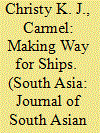

|
|
|
|
|
| Summary/Abstract |
This article foregrounds the interlinkages between the urban space-making of Kochi, religion and the displacement of shore communities in the decades after the Independence of India in 1947. I analyse the happenings and narratives around post-Independent India’s development initiatives as a site to understand space, land and sea as crucial resources in relation to the development of the city and the displacement of the shore communities. Specifically, I examine how the establishment of the Cochin Shipyard, a public-sector company which builds and repairs ships, is entangled with displacement and religion in the development history of Kochi, a comparatively small port city on the south-western coast of the Indian subcontinent. I also trace the refiguring of the displaced people’s land as the place of ‘revengeful ghosts’ in vernacular literature, which, I argue, shows anxieties about the unjust treatment of the evicted communities. I use a diverse range of sources including newspaper reports, biographical notes, ethnographic accounts, myths and literature to recreate this forgotten chapter in the development of Kochi.
|
|
|
|
|
|
|
|
|
|
|
|
|
|
|
|
| 11 |
ID:
134416


|
|
|
|
|
| Summary/Abstract |
Lee, Kingsyhon
China has witnessed several peaceful and successful anti-PX (para-xylene) protests in Xiamen, Dalian, and Ningbo in recent years. However, the protest in Maoming in 2014 turned out to be a noteworthy exception. By using participant observation and in-depth interview data, this article raises the following observations: first, in spite of official propaganda, Maoming citizens actually understand the environmental risk of PX production because of their personal experiences with existing pollution as well as from their knowledge of the Xiamen incident. Secondly, the Maoming protest proceeded in a less organised manner, which explains its violent tendencies. Finally, the large-scale protest was able to proceed without the support of mainstream media and the middle class due to the use of online social media and local knowledge of the urban terrain.
|
|
|
|
|
|
|
|
|
|
|
|
|
|
|
|
| 12 |
ID:
185590


|
|
|
|
|
| Summary/Abstract |
This article analyses how the demolition of the Babri Masjid by Hindu nationalists and the communal violence in its aftermath (1992–93) is remembered in a predominantly Muslim slum neighbourhood in Mumbai. By drawing on ethnographic fieldwork, it considers how a traumatic event is given meaning through fragmented memories inscribed in the urban space. A nuanced analysis of the recollections of the city’s Muslim poor, who faced the main brunt of the violence, suggests that the spatial context of the Muslim neighbourhoods provide a safe social backdrop for the expression of an otherwise suppressed memory that has been pushed by the official narratives of the past into marginality, leading to the creation of an alternative sociality that addresses community concerns to break the hold of the past and imagine a future of peaceful cohabitation.
|
|
|
|
|
|
|
|
|
|
|
|
|
|
|
|
| 13 |
ID:
140442
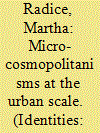

|
|
|
|
|
| Summary/Abstract |
Scholars may no longer see cosmopolitanism as the preserve of the jet-setting elite, but they still tend to focus on international travel as the primary means of acquiring cosmopolitan competence. However, one should not confuse mindsets with mileage: if travel does not always generate cosmopolitanism, then neither is it a precondition for it, so stay-at-homes can become cosmopolitan too. This article draws on ethnographic fieldwork in multiethnic neighbourhoods of Montréal, Quebec, to show how cosmopolitanism can be produced and practised within the microcosm of the city. While international mobility is not necessarily part of these negotiations of difference, other kinds of spatial and social mobility are, especially intra-urban mobility and mobility of the imagination. Examining micro-cosmopolitanism at the urban scale, however, also reveals that practices of and aspirations towards cosmopolitanism do not necessarily coincide.
|
|
|
|
|
|
|
|
|
|
|
|
|
|
|
|
| 14 |
ID:
164713


|
|
|
|
|
| Summary/Abstract |
Vietnam has a long tradition of social engineering through which the ordering of urban space has effectively been used to enforce the state's vision of political and social order. With the country currently in transition from a centrally planned to a market‐oriented economy, the ordering of urban spaces is currently all the more important. This is prominently manifested in the numerous beautification projects that are being implemented in Vietnamese cities. This article explores recent ordering endeavours and considers the way they are legitimated and contested in Vietnam's new socio‐political context. Three beautification projects in Hanoi are examined using materials from policy documents, professional journals and media coverage. The article argues that state ordering actions and the ‘exemplary’ urban spaces they seek to create are embodiments of a complex system of orders of powers in transitional Vietnam, in which political visions of modernist socialism and the new market‐oriented agenda are sometimes in alignment and sometimes clash. Overall, the state's failure in sustaining these ‘exemplary’ urban spaces is emblematic of this hybrid system.
|
|
|
|
|
|
|
|
|
|
|
|
|
|
|
|
| 15 |
ID:
099636
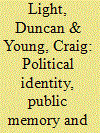

|
|
|
|
|
| Publication |
2010.
|
| Summary/Abstract |
This article analyses the inter-relationship between political identity, public memory and urban space in South-east Europe through a case study of Parcul Carol I (Carol I Park) in Bucharest, Romania from 1906 to the present. The article analyses how the urban cultural landscape has been reshaped to support the political ambitions of three successive regimes-Romania as a kingdom and liberal constitutional monarchy (1881-1938); state-socialist Romania (1947-1989); and the post-socialist Romanian state from 1989. The article highlights complex continuity from the state-socialist period under post-socialism, rather than destruction of the landscape of state-socialism, combined with the return of pre-socialist landscape elements. The article argues for the need for studies of the fate of state-socialist urban landscapes under post-socialism which consider the complexities introduced by the persistence of landscape elements from the pre-socialist and state-socialist periods and their combination with pre-socialist and post-socialist landscapes to produce hybrid memory-scapes and spaces of the nation.
|
|
|
|
|
|
|
|
|
|
|
|
|
|
|
|
| 16 |
ID:
132387


|
|
|
|
|
| Publication |
2014.
|
| Summary/Abstract |
Allegations of police brutality, unlawful detention, and other breaches of civil liberties during the G20 in Toronto in June 2010 provide an important case through which to understand the changing nature of security and policing, raising questions about the political implications of such shifts in terms of police accountability, transparency, and democracy. Within the field of public policing, scholars predicted that globalization processes would weaken public policing as a dominant policing institution. Instead, it has expanded, in part, through the convergence of internal and international dimensions of security, whereby new policy networks cooperate in matters of policing and security in a new integrated model, the result of which is a further militarization of urban space and expanded markets for security, leading to the securitization of everyday life. This article examines the case of Toronto's hosting of the G20 and the role that the Integrated Security Unit-led by the RCMP and including private security firms-played. By focusing on the role of multilateral networks that include private sector actors, we examine the implications of the privatization and securitization of policing for democracy, citizenship, and accountability, looking at how they affect the ability of publics to engage in public debate, to consult, or to protest policies.
|
|
|
|
|
|
|
|
|
|
|
|
|
|
|
|
| 17 |
ID:
183483
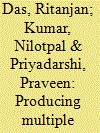

|
|
|
|
|
| Summary/Abstract |
This article examines two simultaneous dynamics in contemporary India: the development of new urban spaces, and an intensification of Hindu nationalism (Hindutva). Examining the case of Noida (a township adjacent to Delhi), this article suggests that the entrepreneurial mode of urban development [Harvey 2006. Spaces of Global Capitalism. New York: Verso] has restructured local spaces, which in turn may give rise to rival attempts at group making, seeking to recreate exclusive identities out of choice and resentment to mobilise political action. Such rival attempts may enable Hindutva to entrench itself in local milieus through multiple modes, including the soft mode of ‘neo-Hindutva’. Overall, the article outlines the dynamic association between new urban processes and exclusivist/nativist forms of politics in contemporary India.
|
|
|
|
|
|
|
|
|
|
|
|
|
|
|
|
| 18 |
ID:
133830
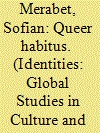

|
|
|
|
|
| Publication |
2014.
|
| Summary/Abstract |
Based on ethnographic and theoretical material, this article focuses on the interaction of queer bodies within particular urban spaces in Beirut. By highlighting bodily performances that challenge normative behaviour in contemporary Lebanon, the article makes a case for the production of a queer habitus, which finds itself expressed in different ways that all emphasise the importance of bodily and mental dispositions of queer individuals in forming their own gender and class identities.
|
|
|
|
|
|
|
|
|
|
|
|
|
|
|
|
| 19 |
ID:
095884
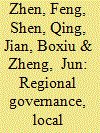

|
|
|
|
|
| Publication |
2010.
|
| Summary/Abstract |
Although the current practice of administrative division adjustment in China may help to facilitate regional governance and urbanization economies, it does not effectively resolve the fundamental conflicts between the central city and surrounding county-level cities.
|
|
|
|
|
|
|
|
|
|
|
|
|
|
|
|
| 20 |
ID:
167939
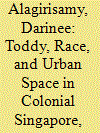

|
|
|
|
|
| Summary/Abstract |
British Malaya's toddy industry features in history as a problem that plagued the plantation economy, when the city toddy shop was no less important in contributing to a racialized discourse of modernity in Singapore. Although colonial policy served to engender the racialization of toddy drinking as a peculiarly Tamil vice, toddy's social life in Singapore demonstrates that it became the poor man's beer regardless of race. The alcoholic drink gave rise to new adaptations, enterprises, and innovations in colonial Singapore, thus carving out a unique place for itself in the city's cultural landscape. Yet, Singapore's toddy industry dominated the public spotlight for less palatable reasons, which rendered it the subject of numerous demands for increased government regulation. The colonial government responded with a slew of measures that often differed from the federation's toddy policy. Singapore's toddy industry yielded divergent imaginaries of modernity, particularly in the aftermath of the Second World War. Some reformers sought its abolition or relocation away from city spaces, whilst others demanded its modernization on the grounds that this meagre establishment was the labourer's sole source of recreation. In light of recent developments that have prompted the government's intervention in limiting migrant labourers’ access to alcohol, this article will examine the considerations that informed the colonial establishment's urban toddy policy and its corresponding impact on Singapore society as it sped towards decolonization. Through an exploration of toddy's treatment in the English-language press, oral histories, and colonial office records, this article seeks to contribute perspectives on an aspect of Singapore's social history that remains largely unexplored.
|
|
|
|
|
|
|
|
|
|
|
|
|
|
|
|
|
|
|
|
|